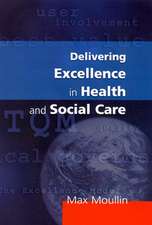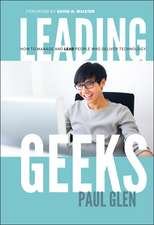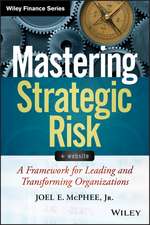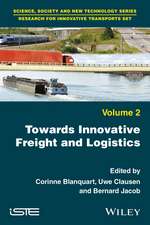Enabling Things to Talk: Designing IoT solutions with the IoT Architectural Reference Model
Editat de Alessandro Bassi, Martin Bauer, Martin Fiedler, Thorsten Kramp, Rob van Kranenburg, Sebastian Lange, Stefan Meissneren Limba Engleză Hardback – 14 noi 2013
The Architectural Reference Model (ARM), presented in this book by the members of the IoT-A project team driving this harmonization effort, makes it possible to connect vertically closed systems, architectures and application areas so as to create open interoperable systems and integrated environments and platforms. It constitutes a foundation from which software companies can capitalize on the benefits of developing consumer-oriented platforms including hardware, software and services.
The material is structured in two parts. Part A introduces the general concepts developed for and applied in the ARM. It is aimed at end users who want to use IoT technologies, managers interested in understanding the opportunities generated by these novel technologies, and system architects who are interested in an overview of the underlying basic models. It also includes several case studies to illustrate how the ARM has been used in real-life scenarios. Part B then addresses the topic at a more detailed technical level and is targeted at readers with a more scientific or technical background. It provides in-depth guidance on the ARM, including a detailed description of a process for generating concrete architectures, as well as reference manuals with guidelines on how to use the various models and perspectives presented to create a concrete architecture. Furthermore, best practices and tips on how system engineers can use the ARM to develop specific IoT architectures for dedicated IoT solutions are illustrated and exemplified in reverse mapping exercises of existing standards and platforms.
| Toate formatele și edițiile | Preț | Express |
|---|---|---|
| Paperback (1) | 361.31 lei 43-57 zile | |
| Springer Berlin, Heidelberg – 23 aug 2016 | 361.31 lei 43-57 zile | |
| Hardback (1) | 365.89 lei 43-57 zile | |
| Springer Berlin, Heidelberg – 14 noi 2013 | 365.89 lei 43-57 zile |
Preț: 365.89 lei
Preț vechi: 457.37 lei
-20% Nou
Puncte Express: 549
Preț estimativ în valută:
70.07€ • 72.20$ • 58.70£
70.07€ • 72.20$ • 58.70£
Carte tipărită la comandă
Livrare economică 24 februarie-10 martie
Preluare comenzi: 021 569.72.76
Specificații
ISBN-13: 9783642404023
ISBN-10: 3642404022
Pagini: 350
Ilustrații: X, 349 p. 131 illus., 116 illus. in color.
Dimensiuni: 155 x 235 x 30 mm
Greutate: 0.63 kg
Ediția:2013
Editura: Springer Berlin, Heidelberg
Colecția Springer
Locul publicării:Berlin, Heidelberg, Germany
ISBN-10: 3642404022
Pagini: 350
Ilustrații: X, 349 p. 131 illus., 116 illus. in color.
Dimensiuni: 155 x 235 x 30 mm
Greutate: 0.63 kg
Ediția:2013
Editura: Springer Berlin, Heidelberg
Colecția Springer
Locul publicării:Berlin, Heidelberg, Germany
Public țintă
Professional/practitionerCuprins
Introduction to the Internet of Things.- The Need for a Common Ground for the IoT — The History and Reasoning Behind the IoT — A Project.- The IoT Architectural Reference Model as Enabler.- IoT in Practice: Examples — IoT in Logistics and Health.- IoT — A Guidance to the ARM.- A Process to Generate Concrete Architectures.- IoT Reference Model.- IoT Reference Architecture.- The IoT ARM Reference Manual.- Interactions.- Toward a Concrete Architecture.- ARM Testimonials.- Summary and Outlook.
Recenzii
From the reviews:
"If your goal is to learn or employ IoT technologies, this book serves as a worthy starting point for that journey; you will certainly benefit from having it in your library for future reference." Nicholas Loulloudes, ACM Computing Reviews, June 2014
"If your goal is to learn or employ IoT technologies, this book serves as a worthy starting point for that journey; you will certainly benefit from having it in your library for future reference." Nicholas Loulloudes, ACM Computing Reviews, June 2014
Notă biografică
The IoT-Architecture project (IoT-A) is the European Commission’s flagship project in the European Union’s Seventh Framework Program for Research and Development with respect to establishing an architecture for the Internet of Things. Together, the editors and contributing authors represent more than 20 large industrial companies and research institutions, including Alcatel-Lucent, IBM , Ericsson, NEC, NXP, SAP, Siemens, and the Universities of Rome “La Sapienza,” St. Gallen, Surrey, and Würzburg, as well as CEA, CFRG, FhG, and VTT.
Textul de pe ultima copertă
The Internet of Things (IoT) is an emerging network superstructure that will connect physical resources and actual users. It will support an ecosystem of smart applications and services bringing hyper-connectivity to our society by using augmented and rich interfaces. Whereas in the beginning IoT referred to the advent of barcodes and Radio Frequency Identification (RFID), which helped to automate inventory, tracking and basic identification, today IoT is characterized by a dynamic trend toward connecting smart sensors, objects, devices, data and applications. The next step will be “cognitive IoT,” facilitating object and data re-use across application domains and leveraging hyper-connectivity, interoperability solutions and semantically enriched information distribution.
The Architectural Reference Model (ARM), presented in this book by the members of the IoT-A project team driving this harmonization effort, makes it possible to connect vertically closed systems, architectures and application areas so as to create open interoperable systems and integrated environments and platforms. It constitutes a foundation from which software companies can capitalize on the benefits of developing consumer-oriented platforms including hardware, software and services.
The material is structured in two parts. Part A introduces the general concepts developed for and applied in the ARM. It is aimed at end users who want to use IoT technologies, managers interested in understanding the opportunities generated by these novel technologies, and system architects who are interested in an overview of the underlying basic models. It also includes several case studies to illustrate how the ARM has been used in real-life scenarios. Part B then addresses the topic at a more detailed technical level and is targeted at readers with a more scientific or technical background. It provides in-depth guidance on the ARM, including a detailed description of a process for generating concrete architectures, as well as reference manuals with guidelines on how to use the various models and perspectives presented to create a concrete architecture. Furthermore, best practices and tips on how system engineers can use the ARM to develop specific IoT architectures for dedicated IoT solutions are illustrated and exemplified in reverse mapping exercises of existing standards and platforms.
The Architectural Reference Model (ARM), presented in this book by the members of the IoT-A project team driving this harmonization effort, makes it possible to connect vertically closed systems, architectures and application areas so as to create open interoperable systems and integrated environments and platforms. It constitutes a foundation from which software companies can capitalize on the benefits of developing consumer-oriented platforms including hardware, software and services.
The material is structured in two parts. Part A introduces the general concepts developed for and applied in the ARM. It is aimed at end users who want to use IoT technologies, managers interested in understanding the opportunities generated by these novel technologies, and system architects who are interested in an overview of the underlying basic models. It also includes several case studies to illustrate how the ARM has been used in real-life scenarios. Part B then addresses the topic at a more detailed technical level and is targeted at readers with a more scientific or technical background. It provides in-depth guidance on the ARM, including a detailed description of a process for generating concrete architectures, as well as reference manuals with guidelines on how to use the various models and perspectives presented to create a concrete architecture. Furthermore, best practices and tips on how system engineers can use the ARM to develop specific IoT architectures for dedicated IoT solutions are illustrated and exemplified in reverse mapping exercises of existing standards and platforms.
Caracteristici
First comprehensive overview of the European Architecture Reference Model (ARM) for the Internet of Things Includes both a reference manual and numerous best practices and tips for implementing the ARM Illustrates ARM implementations on the basis of several industrial case studies Written in cooperation by leading software and solution providers (Alcatel-Lucent, IBM , Ericsson, NEC, NXP, SAP, Siemens) and top-level research institutions Includes supplementary material: sn.pub/extras




















